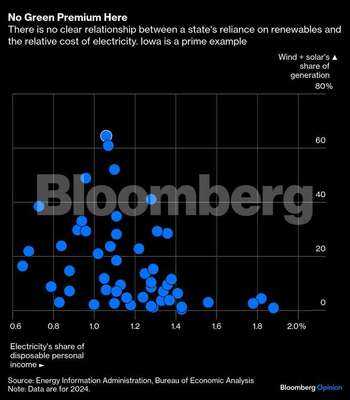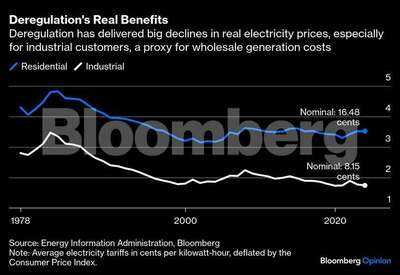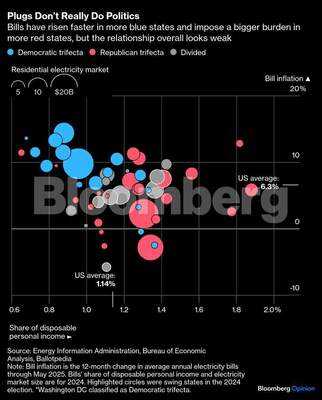At his Senate confirmation hearing, Energy Secretary Chris Wright confessed he was new to politics. He is a fast learner. Wright lamented in a recent interview with Politico that President Donald Trump’s administration would be blamed for rising electricity bills, even though it was really Democrats’ fault. His instinct about a brewing midterms energy backlash is sound. His simplistic take on what’s happening with prices needs work.
Plug prices are the new pump prices for economic anxiety, and they feature in state elections already. US presidents are traditionally, and usually wrongly, blamed for higher gasoline prices. Electricity is more complicated, mixing regulated and market prices that are subject to state and regional forces. Ironically, Trump can be directly blamed in this case. Before getting to that, though, some misguided preconceptions need addressing.
State regulators play the primary role in setting power prices and they are subject to state oversight and policies. Plotting bills’ inflation and burden on income against the political alignments of states displays little to no correlation, however. More of the blue-trifecta states — where Democrats hold the governor’s seat and both legislative chambers — have seen higher than average bill inflation this year. But electricity takes a bigger bite of incomes in more of their red counterparts. Seems like a wash.

Wright’s jab at Democrats centered on their penchant for green power, which he has dismissed as costly and unreliable. Again, however, there is no discernable correlation between a state’s reliance on wind and solar power and electricity costs. Indeed, Iowa, a Republican stronghold where Wright gave his interview, is a renewables standout and its bills are relatively low as a share of income.
Indeed, focusing on generation misses the bigger picture, according to Jim Murchie, an expert on, and investor in, energy infrastructure, and co-founder of Energy Income Partners LLC, an investment management firm. In a recent blog post, he broke down residential electricity prices into their three principle components: Generation, transmission and distribution.Of the three, he estimates that distribution — the lower-voltage networks delivering power locally — has accounted for roughly two-thirds of the increase in average prices over the past decade.

This observation fits with trends in utility investment, with capital expenditure on distribution having doubled in real terms over the past decade compared with flat spending on transmission and generation. As regulated monopolies, utilities earn that investment back, plus a return, as set by regulators and spread across the kilowatt-hours consumed by customers. That investment includes not just the cost of equipment but also the overhead of paying benefits in the most labor-intensive part of the industry. The more spent, the higher the bill.
Murchie’s point isn’t that generation costs can’t also go up; these account for a fifth of the increase in residential tariffs over the past decade. Rather, distribution represents the bigger target. On that, he recommends regulators offer utilities more sophisticated incentives than just build-and-profit; encouraging efficiency by allowing them to keep some portion of savings temporarily.

There is also a warning in that thesis. Some state politicians in truly competitive power markets, spooked by higher bills, are contemplating winding the clock back on deregulation. They are considering allowing regulated utilities to build and own power plants rather than leaving it to market-driven independent generators. This fits with the anti-renewables zeitgeist in Washington, too, since utilities favor gas over green, accounting already for 60% of planned gas-fired generating capacity but only 9% of wind and solar capacity.
But broad reregulation to meet the challenges of the artificial intelligence boom would be nuts. Deregulation has, overall, been a resounding success, delivering big real price declines.
Rather than states pushing a lot of utility-owned capacity into the market, AI giants adding hefty new loads should be made to contract for new, competitive generation that can boost the grid’s resilience (see this) without burdening households. Indeed, done right, this could end up reducing costs across the system, Murchie points out: Since electricity prices are calculated as costs divided by kilowatt-hours consumed, a big bump to that denominator represents a potential opportunity.

“Done right” does a lot of work there, obviously. Which brings us back to Trump and his attacks on the fastest-growing source of new capacity, renewables.
The administration just ordered work to stop on a large wind project off the coast of Rhode Island. Unlike the New York project blocked temporarily earlier this summer, Revolution Wind is already almost completely built; the money’s already spent. This was initially justified on nebulous grounds of “national security.” Such is the administration’s shambolic insouciance, however, that Environmental Protection Agency head Lee Zeldin seemingly couldn’t even stick to that, rushing to tell Fox News that the president just doesn’t like wind power.
I highlight the absurdity because voters should understand that Trump’s un-seriousness about energy will cost them. We are already witnessing the impact of burgeoning datacenters on household power costs. Yet in the administration’s “AI Action Plan”, all of one page out of 29 addresses the power grid, with no mention of prices or costs. Meanwhile, apart from attacking nearly built wind projects, Republicans have undercut incentives for renewables, and Wright recently pulled a federal loan guarantee for a big Midwestern transmission project that has undergone years of regulatory and legal review. Meanwhile, there is the inflationary impact of tariffs on equipment and metals and a broader, rising risk to confidence in US economic policy, and thereby capital costs, as Trump attacks institutional foundations such as central bank independence.
Given the complexities behind power bills, everyday Americans can understandably struggle to properly assign responsibility for inflation. They may recognize wanton destruction easily enough, though.
Plug prices are the new pump prices for economic anxiety, and they feature in state elections already. US presidents are traditionally, and usually wrongly, blamed for higher gasoline prices. Electricity is more complicated, mixing regulated and market prices that are subject to state and regional forces. Ironically, Trump can be directly blamed in this case. Before getting to that, though, some misguided preconceptions need addressing.
State regulators play the primary role in setting power prices and they are subject to state oversight and policies. Plotting bills’ inflation and burden on income against the political alignments of states displays little to no correlation, however. More of the blue-trifecta states — where Democrats hold the governor’s seat and both legislative chambers — have seen higher than average bill inflation this year. But electricity takes a bigger bite of incomes in more of their red counterparts. Seems like a wash.
Wright’s jab at Democrats centered on their penchant for green power, which he has dismissed as costly and unreliable. Again, however, there is no discernable correlation between a state’s reliance on wind and solar power and electricity costs. Indeed, Iowa, a Republican stronghold where Wright gave his interview, is a renewables standout and its bills are relatively low as a share of income.
Indeed, focusing on generation misses the bigger picture, according to Jim Murchie, an expert on, and investor in, energy infrastructure, and co-founder of Energy Income Partners LLC, an investment management firm. In a recent blog post, he broke down residential electricity prices into their three principle components: Generation, transmission and distribution.Of the three, he estimates that distribution — the lower-voltage networks delivering power locally — has accounted for roughly two-thirds of the increase in average prices over the past decade.

This observation fits with trends in utility investment, with capital expenditure on distribution having doubled in real terms over the past decade compared with flat spending on transmission and generation. As regulated monopolies, utilities earn that investment back, plus a return, as set by regulators and spread across the kilowatt-hours consumed by customers. That investment includes not just the cost of equipment but also the overhead of paying benefits in the most labor-intensive part of the industry. The more spent, the higher the bill.
Murchie’s point isn’t that generation costs can’t also go up; these account for a fifth of the increase in residential tariffs over the past decade. Rather, distribution represents the bigger target. On that, he recommends regulators offer utilities more sophisticated incentives than just build-and-profit; encouraging efficiency by allowing them to keep some portion of savings temporarily.
There is also a warning in that thesis. Some state politicians in truly competitive power markets, spooked by higher bills, are contemplating winding the clock back on deregulation. They are considering allowing regulated utilities to build and own power plants rather than leaving it to market-driven independent generators. This fits with the anti-renewables zeitgeist in Washington, too, since utilities favor gas over green, accounting already for 60% of planned gas-fired generating capacity but only 9% of wind and solar capacity.
But broad reregulation to meet the challenges of the artificial intelligence boom would be nuts. Deregulation has, overall, been a resounding success, delivering big real price declines.
Rather than states pushing a lot of utility-owned capacity into the market, AI giants adding hefty new loads should be made to contract for new, competitive generation that can boost the grid’s resilience (see this) without burdening households. Indeed, done right, this could end up reducing costs across the system, Murchie points out: Since electricity prices are calculated as costs divided by kilowatt-hours consumed, a big bump to that denominator represents a potential opportunity.
“Done right” does a lot of work there, obviously. Which brings us back to Trump and his attacks on the fastest-growing source of new capacity, renewables.
The administration just ordered work to stop on a large wind project off the coast of Rhode Island. Unlike the New York project blocked temporarily earlier this summer, Revolution Wind is already almost completely built; the money’s already spent. This was initially justified on nebulous grounds of “national security.” Such is the administration’s shambolic insouciance, however, that Environmental Protection Agency head Lee Zeldin seemingly couldn’t even stick to that, rushing to tell Fox News that the president just doesn’t like wind power.
I highlight the absurdity because voters should understand that Trump’s un-seriousness about energy will cost them. We are already witnessing the impact of burgeoning datacenters on household power costs. Yet in the administration’s “AI Action Plan”, all of one page out of 29 addresses the power grid, with no mention of prices or costs. Meanwhile, apart from attacking nearly built wind projects, Republicans have undercut incentives for renewables, and Wright recently pulled a federal loan guarantee for a big Midwestern transmission project that has undergone years of regulatory and legal review. Meanwhile, there is the inflationary impact of tariffs on equipment and metals and a broader, rising risk to confidence in US economic policy, and thereby capital costs, as Trump attacks institutional foundations such as central bank independence.
Given the complexities behind power bills, everyday Americans can understandably struggle to properly assign responsibility for inflation. They may recognize wanton destruction easily enough, though.
You may also like

US tariff hike on Indian exports 'discriminatory': Former Commerce Secretary

Hollyoaks child goes missing leaving family distraught as Darren blames two villagers

Telangana CM conducts aerial survey of flood-hit districts

Diamond Polishers Face 30% Revenue Hit In FY26 As US Tariffs Bite: Crisil Ratings

Mum thought 17-month-old daughter was just scared of dark – now she has just one eye






